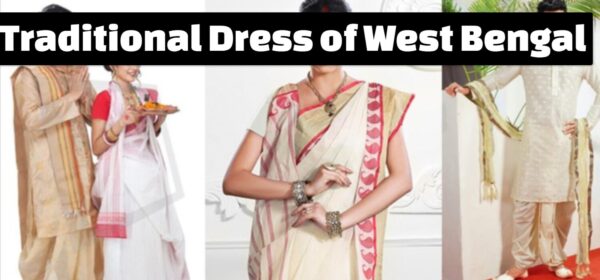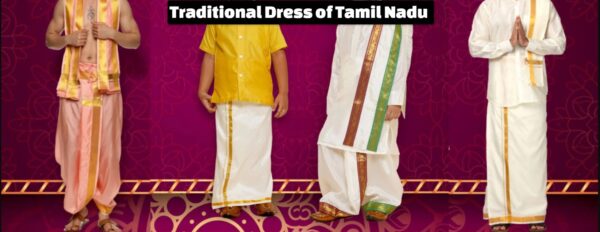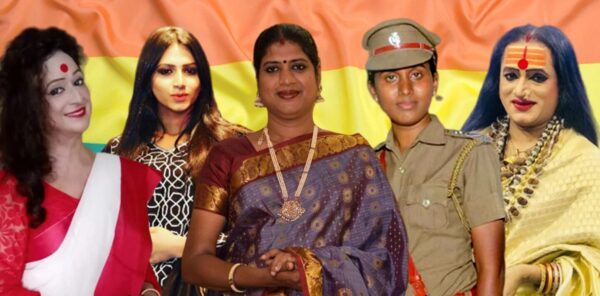West Bengal is a lively state, boasting of its music, cuisine literature, painting and amazing clothes. The state is known for its celebrations of Durga Pooja. The traditional dress worn during various events is a an integral part of the culture. Here are some traditional clothes used by women and men throughout West Bengal.
Also Read: Traditional Dress of Haryana
Traditional Dress of Bengali Women
1. Sarees
Sarees are a traditional dress worn by Women who reside in West Bengal. The style of draping sarees is distinctive in comparison to other states. Some of the names that are reputable are:
2. Korial and Garad Sarees
Garads are the traditional Bengali Saris that are white and have bordering in red. These sarees are believed to have religious significance and are popular for Durga Poojas, wedding ceremonies and weddings. The typical Bengali Conch Shell or ivory is a popular choice along by Red Bangles. Garad Sarees represent the height of class and style for Bengali women.
3. Tant Sarees
The term Tant comes from the loom upon which the saree is made. Tant sarees have become extremely sought-after the traditional lightweight sarees. They are ideal for humid and hot climates. They are also made with specific designs and florals that span thick borders.
4. Dhakai Jamdani
This gorgeous gown is believed to have come from Dhaka. Its distinctiveness lies in Emerald embedded into it. Beautiful delicate floral designs that are woven using gold and silver threads. However, the tedious and time-consuming process explains the price for these silk sarees.
5. Tussar as well as Kantha silks
Malda district in Bengal is among the most important hubs of this Tussar and sarees. They are more delicate and are vibrant in color. These sarees are constructed from silk with a golden sheen and are decorated with contemporary and traditional designs on pallu. Kanta sarees feature flowing stitches that are bright in hues. It’s both heavy and light with intricate designs.
6. Muslin Cotton and Murshidabad Silks
Muslin cotton can be described as a high-end silk saree that is made from soft paste shades. Because of their delicate designs they provide a clean but sophisticated appearance. Murshidabad Silks are high-quality silk sarees with vibrant colors. They feature traditional batik patterns and block patterns.
7. Baluchari Sarees
Baluchari Saris are made from fine silk garments. It is adorned with golden embroidery and decorated by Indian Mythological characters. They are also known as Swarana sarees because of their vibrant golden borders. The pallus is best not pleated, and shows its overall style and design.
8. Kurta along with a salwar with gorgeous dupattas
Traditional salwars and kurtas are often paired with bright embroidery, dupattas and exotic designs. The fashions of Jamdani or Kantha, Bengali women often wear kurta salwars paired with stunning, luxurious silk or cotton dupattas.
Traditional Dress of Men in West Bengal
1. Panjabi Dhoti
Bengali men wear panjabi clothes, which are as is the case with the north’s plain dhoti and kurta. Only difference lies in in the fabric employed, which is Muga Silk, Tusshar silk as well as cotton silk. Today, Panjabi dresses are paired with trousers and jeans. Garad silk kurtas are available in cream, beige, as well as honey colour shades.
2. Kurta Pajama
Kurtas are unique long-length clothing that is worn with loosely fitting pants. They are considered to be normal clothes and are typically composed of cotton or silk.
3. Lungi (Dhotis)
In contrast to that of South Indian, even Bengalis wear a lungi, similar to the dhoti. They are long pieces of white cloth that is draped around the waist and tied on the lower back, close to the tailbone.
Conclusion
The lively tradition that is West Bengal is depicted in the traditional attire of Bengal. From the exquisite sarees that are available in various styles and fabrics like Dhakai Jamdani, to the cosy Panjabi Dhoti, Bengali males and females wear vibrant attire for any occasion.Bengal’s traditional attire is still essential to the identity of its culture.




